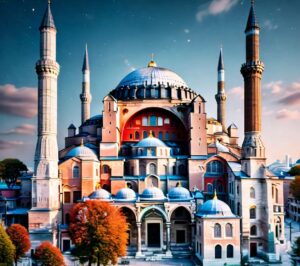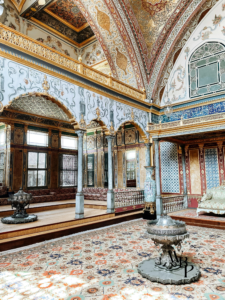History of Turkey
Turkey, situated at the crossroads of Europe and Asia, has a long and complex history shaped by a blend of cultures, religions, and empires. Its history can be divided into several key periods: the ancient civilizations, the rise and fall of the Byzantine Empire, the Ottoman Empire, and the foundation of the modern Republic of Turkey. Below is a comprehensive overview of these major periods in Turkish history.
-
Ancient Civilizations and Early Anatolia (2000 BCE – 330 CE)
The history of Turkey begins in the region of Anatolia (modern-day Asian Turkey), which has been home to various ancient civilizations. Some of the earliest known civilizations that settled in this region include the Hittites, Phrygians, and Lydians.
- Hittites (c. 1600–1178 BCE): The Hittites established a powerful empire in central Anatolia. They were known for their military prowess and early development of ironworking. The Hittite Empire was one of the major powers of the ancient world, often in conflict with Egypt and Assyria.
- Phrygians and Lydians (1200–546 BCE): Following the decline of the Hittites, the Phrygians and later the Lydians dominated the region. The Lydians are credited with inventing coinage, an innovation that significantly influenced trade in the ancient world.
- Greek Colonization: Coastal Anatolia, particularly along the Aegean Sea, saw the rise of Greek colonies, such as Ephesus, Smyrna (modern Izmir), and Miletus. These cities became important centers of trade and culture, integrating Anatolia into the Hellenistic world.
-
Byzantine Empire (330 – 1453)
The Byzantine Empire, also known as the Eastern Roman Empire, was established in 330 CE when Emperor Constantine I moved the capital of the Roman Empire to Byzantium, renaming it Constantinople (modern Istanbul).
- Christianization and Roman Legacy: The Byzantine Empire continued the traditions of the Roman Empire while becoming a center of Christian culture. Constantinople became the largest and wealthiest city in Europe, with monuments like the Hagia Sophia symbolizing Byzantine architectural achievements.
- Constant Threats and Decline: The empire faced continuous threats from Persian, Arab, and later, Seljuk Turkish invasions. The Byzantine Empire’s territorial control gradually shrank over the centuries.
- Fall of Constantinople (1453): After centuries of decline, Constantinople fell to the Ottoman Turks under Sultan Mehmed II, marking the end of the Byzantine Empire and the beginning of Ottoman rule.
-
The Ottoman Empire (1299 – 1922)
The Ottoman Empire was one of the most important and longest- lasting conglomerates in history. It was founded by Osman I in 1299 and expanded rapidly, eventually controlling vast territories in Southeast Europe, the Middle East, and North Africa.
- Expansion and Conquests: By the mid-15th century, the Ottomans had expanded their rule across the Balkans and captured Constantinople in 1453. The empire continued to grow, reaching its zenith in the 16th century under Sultan Suleiman the Magnificent. Suleiman’s reign saw the expansion of the empire into Hungary, parts of the Arabian Peninsula, and across North Africa.
- Multicultural Empire: The Ottomans ruled over a vast array of ethnic and religious groups, including Christians, Jews, and Muslims. While largely Islamic, the empire allowed a degree of religious tolerance through the millet system, which allowed different communities to govern themselves.
- Decline and “Sick Man of Europe”: By the 19th century, the Ottoman Empire began to decline due to internal strife, economic difficulties, and military defeats. Nationalist movements and external pressures from European powers weakened the empire, earning it the nickname “The Sick Man of Europe.”
- World War I and Collapse: The Ottomans allied with the Central Powers in World War I. Defeated in 1918, the empire disintegrated, leading to the loss of its Arab territories and eventually its European holdings. The empire officially dissolved in 1922, following the Turkish War of Independence.
-
The Republic of Turkey (1923 – Present)
The Republic of Turkey was founded in 1923 by Mustafa Kemal Atatürk, following the collapse of the Ottoman Empire. Atatürk’s reforms radically transformed the country into a secular, modern nation-state.
- Turkish War of Independence (1919–1923): After the defeat in World War I, the Allied powers sought to partition the Ottoman Empire. Atatürk led a successful nationalist movement, defeating occupying forces and negotiating favorable terms at the Treaty of Lausanne in 1923, which recognized Turkey’s independence.
- Atatürk’s Reforms: Mustafa Kemal Atatürk implemented sweeping reforms to modernize and secularize Turkey. The Sultanate was abolished, the Latin alphabet replaced the Arabic script, and the government was secularized. Women’s rights were expanded, and education and industry were modernized.
- Cold War and NATO Membership: During the Cold War, Turkey joined NATO in 1952 and positioned itself as a key ally of the West, balancing its role between the Western and Eastern blocs while maintaining its regional influence.
- Political and Economic Developments (20th Century): Turkey experienced periods of military coups in 1960, 1971, and 1980, often driven by political instability and ideological conflict between secularists and Islamists. The 1990s were marked by economic crises, but major reforms in the early 2000s boosted growth, especially under the leadership of the Justice and Development Party (AKP), led by Recep Tayyip Erdoğan.
- Contemporary Turkey: Under Erdoğan, Turkey has seen significant changes, including a more pronounced role of religion in politics and the reduction of military influence in governance. However, concerns have arisen about increasing authoritarianism, particularly after the failed 2016 coup attempt, which led to widespread purges and changes to the constitution. Turkey continues to play a crucial role in regional geopolitics, particularly in the Middle East and Eastern Mediterranean.
10 of the Most Beautiful Cities in Turkey
-
Istanbul
- Hagia Sophia (Ayasofya): Originally built as a Byzantine cathedral, it later became a mosque and now serves as a museum. Hagia Sophia is one of the most important landmarks in world architecture and a symbol of Istanbul’s diverse heritage.
- Topkapi Palace: Once the primary residence of Ottoman sultans, this sprawling palace complex offers a glimpse into the opulence and power of the Ottoman Empire.
- Blue Mosque (Sultan Ahmed Mosque): Known for its stunning blue tiles, this mosque is one of Istanbul’s most iconic structures and is still in use today.
- Basilica Cistern: An underground Byzantine cistern that supplied water to ancient Constantinople, known for its eerie atmosphere and the famous Medusa heads.
-
Cappadocia
- Göreme National Park and Rock Sites: Known for its surreal landscape of fairy chimneys, rock formations, and cave dwellings, Cappadocia is a UNESCO World Heritage site. It’s also famous for its hot air balloon rides over the unique terrain.
- Underground Cities (Derinkuyu and Kaymakli): Cappadocia is home to ancient underground cities, where early Christians sought refuge from persecution.
- Göreme Open-Air Museum: This museum houses ancient rock-cut churches adorned with beautiful frescoes dating back to the Byzantine period.
-
Ephesus (Efes)
- Temple of Artemis: One of the Seven Wonders of the Ancient World, though only ruins remain today, it is still a site of great historical significance.
- Library of Celsus: A well-preserved Roman structure that was once one of the largest libraries in the ancient world.
- Terrace Houses: Intricate homes of the elite, complete with mosaics and frescoes that provide insight into the luxurious lifestyle of Ephesus’ wealthy residents.
-
Pamukkale
- Travertine Terraces: Pamukkale, meaning “Cotton Castle,” is famous for its dazzling white terraces formed by calcium-rich mineral springs. Tourists can walk on these terraces and bathe in the thermal waters.
- Hierapolis Ancient City: Adjacent to Pamukkale, Hierapolis was an ancient spa city built by the Romans. Its well-preserved ruins include a large theatre, Roman baths, and a necropolis.
-
Antalya and the Turquoise Coast
- Antalya Old Town (Kaleiçi): A picturesque district with winding streets, Ottoman-era houses, and Roman ruins, including Hadrian’s Gate.
- Aspendos Theatre: One of the best-preserved ancient Roman theatres, still used for performances today.
- Olympos and Chimaera: Olympos is an ancient city near the Mediterranean coast, while Chimaera is famous for its eternal flames, caused by natural gas emissions from the rocks.
- Konyaaltı and Lara Beaches: These beaches offer pristine Mediterranean waters and a gateway to the luxury resorts of Turkey’s Riviera.
-
Troy and Gallipoli
- Troy: The legendary city immortalized in Homer’s Iliad, Troy is an archaeological site where visitors can see the ruins of the ancient city, including city walls and the replica of the famous Trojan Horse.
- Gallipoli Peninsula: A site of great historical importance for Turkey, Australia, and New Zealand due to the famous WWI battles. The peninsula has numerous memorials and cemeteries dedicated to soldiers who fought in the Gallipoli Campaign.
-
Mount Nemrut
- Statues of Gods: At the summit of Mount Nemrut in southeastern Turkey, massive stone statues of ancient gods stand in eternal watch. Built by King Antiochus I, the site offers a mysterious and awe-inspiring atmosphere, especially at sunrise and sunset.
-
Ankara
- Anıtkabir: The tomb of Mustafa Kemal Atatürk, the author of the Republic of Turkey.It’s an important site of national significance, with a museum that details Atatürk’s life and legacy.
- Museum of Anatolian Civilizations: Located in Ankara, this museum showcases artifacts from Turkey’s rich history, including Hittite, Phrygian, and Urartian relics.
-
Sumela Monastery
- Monastery in the Mountains: Perched on a steep cliff in the Pontic Mountains near Trabzon, Sumela Monastery offers a breathtaking view and a glimpse into the region’s monastic history. It was founded in the 4th century and is known for its frescoes and isolation.
-
Lake Van and Eastern Turkey
- Akdamar Island: Located in Lake Van, this island is home to the 10th-century Church of the Holy Cross, a beautiful example of Armenian architecture.
- Mount Ararat: The highest peak in Turkey, often associated with the biblical story of Noah’s Ark. Mountaineers often seek to climb this challenging but spiritually significant mountain.
- Van Castle: An ancient fortress overlooking Lake Van, providing a stunning view of the lake and the surrounding landscape.
Conclusion
Turkey’s vast historical and cultural legacy is evident in its wide variety of must-see destinations. From the bustling metropolis of Istanbul to the ancient ruins of Ephesus, the stunning landscapes of Cappadocia, and the serene beaches of the Turquoise Coast, Turkey offers an unparalleled travel experience that blends the old and the new, East and West.


